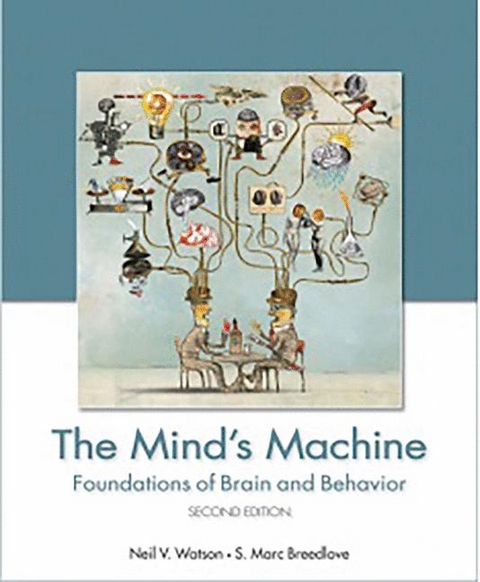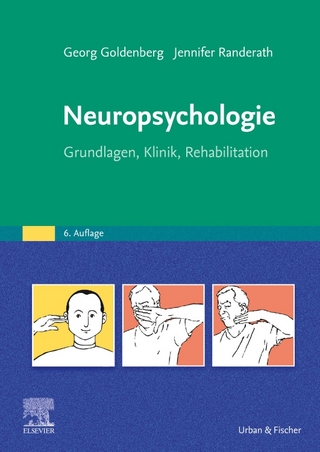
The Mind's Machine
Sinauer Associates Inc.,U.S. (Verlag)
978-1-60535-276-3 (ISBN)
- Keine Verlagsinformationen verfügbar
- Artikel merken
The Mind's Machine, introduced in 2012, was written to impart the core concepts of behavioral neuroscience to students in a diverse range of disciplines, including not only psychology and the other life sciences, but art, philosophy, media studies, linguistics, and the like. Through the use of streamlined text, full-color art, novel pedagogical features, and real-life examples and analogies, the book succeeded in engaging students new to neuroscience without sacrificing accuracy.
Features
NEW! Signs and Symptoms
This new feature highlights important clinical issues related to the chapter topics that apply behavioral neuroscience to the study of clinical disorders.
Vignettes
Each chapter begins with a gripping vignette relating the material that follows to a real-life situation.
Visual Summary
A graphic layout helps organize the material, and directs students to the figures that reinforce each point. Bold-faced key terms, callouts to pertinent figures, and references to the Companion Website are provided.
Parts
Larger, standalone 'Parts' of chaptersare written discretely to maximize flexibility in assigning readings.
Marginal Glossary
Bold-faced terms are defined in the margins of the text to help students identify and learn key terminology as they read.
Researchers at Work
Important discoveries are explained and illustrated to highlight the process of experimentation and hypothesis testing.
QR Codes
Using their smartphones, students can instantly access support material from the Companion Website, such as animations, activities, and videos to further explain topics.
Color Art
The figures are beautifully drawn to aid students' understanding of biological processes. Concisely labeled and explained, the figures are one of the strongest pedagogical features in the text.
Boxes
Boxes describe interesting applications, important methods, sidelights, historical perspectives, or refreshers on theoretical concepts.
A Step Further
This feature offers additional, more advanced material for an instructor who wants to make certain topics more challenging or for students who want to know more
'How's it going?' Questions
At the end of each section are review questions to help students organize and rehearse what they've learned from the text.
Photographs
Photographs show students 'real-life' examples of concepts and topics.
Neil V. Watson and the members of his lab at Simon Fraser University in Vancouver, Canada study sex-related aspects of the structure and function of the nervous system, with ongoing grant support from the Natural Sciences and Engineering Research Council of Canada. His work on topics ranging from the effects of steroids on cell survival, to the neural control of reproductive behavior, to human cognitive sex differences has appeared in a variety of journals, including the Journal of Neuroscience, the Proceedings of the National Academy of Science, and Brain Research. Dr. Watson received his undergraduate and master's degrees from the University of Western Ontario and his Ph.D. from the University of British Columbia. Following a postdoctoral fellowship at the University of California, Berkeley, he joined the faculty at SFU in 1996 where he is now Professor of Neuroscience in the Department of Psychology. He teaches biological psychology to hundreds of undergraduate and graduate students each year. S. Marc Breedlove, the Barnett Rosenberg Professor of Neuroscience at Michigan State University, has written over 130 scientific articles investigating the role of hormones in shaping the developing and adult nervous system, publishing in journals including Science, Nature, Nature Neuroscience, and the Proceedings of the National Academy of Science. He is also passionate about teaching—in the classroom, and in the greater community through interviews with the Washington Post, Los Angeles Times, New York Times, and Newsweek, as well as broadcast programs such as All Things Considered, Good Morning America, and Sixty Minutes. He has active grant support from the National Institute of Neurological Disorders and Stroke and the National Institute of Mental Health. Dr. Breedlove is a Fellow of the American Association for the Advancement of Science and the Association for Psychological Science.
1. An Introduction to Brain and Behavior.- Updated and new facts and figures to illustrate the complexity of the brain.- Discussion of the historical origins and accelerating pace of discovery in neuroscience.- Enhanced discussion of neuroplasticity as a general feature of neural systems.- 2. Cells and Structures: The Anatomy of the Nervous System.- Signs & Symptoms: Stroke.- Revamped discussion of somatic and autonomic divisions of the peripheral nervous system.- Improved illustrations using color coding to link functional and anatomical divisions of the spinal cord.- Improved discussion of the blood supply of the brain.- New or improved figures depicting types of strokes, cranial nerves, and neuronal structures.- 3. Neurophysiology: The Generation, Transmission, and Integration of Neural Signals.- Signs & Symptoms: Multiple Sclerosis.- Improved discussion of steps in synaptic transmission.- Refinement of the text in the Visual Summary.- 4. The Chemistry of Behavior: Neurotransmitters and Neuropharmacology.- Signs & Symptoms: Medical Interventions for Substance Abuse.- Improved and expanded discussion of neurotransmitters.- Updated discussion of cannabinoids and hallucinogens.- Updated text and figures on drug abuse.- Updates to reflect DSM-5 changes.- 5. The Sensorimotor System.- Signs & Symptoms: Hazards of Painlessness.- Updated placement of representation for the neck in the sensory and motor cortex, following a 2015 research report.- 6. Hearing, Balance, Taste, and Smell.- Signs & Symptoms: Restoring Auditory Stimulation in Deafness.- New and improved description and illustrations of the function and frequency mapping of the basilar membrane.- Updated discussion of sensory adaptations in other species.- Clearer presentation of vestibular function.- 7. Vision: From Eye to Brain.- Signs & Symptoms: Robot Eyes?.- Improved discussion of visual receptive fields.- Streamlined discussion of photopic and scotopic visual systems.- 8. Hormones and Sex.- Signs & Symptoms: Psychosocial Dwarfism.- Discussion of effects of hormones in pregnancy on cognition.- Updated discussion of prenatal influences on human sexual orientation<.- 9. Homeostasis.- Signs & Symptoms: Fat-Busting Surgery.- New discussion of allostatic load.- Updated discussion and improved illustration of the hypothalamic appetite controller.- New illustration of bariatric surgery.- 10. Biological Rhythms and Sleep.- Signs & Symptoms: REM Behavior Disorder.- Updated discussion of brain regions controlling sleep states.- Discussion of new evidence that toxins are 'cleaned out' of the brain during sleep.- 11. Emotions, Aggression, and Stress.- Signs & Symptoms: Long-term consequences of childhood bullying.- Update on fear of suffocation in patient S.M..- Discussion of maternal aggression.- 12. Psychopathology: The Biology of Behavioral Disorders.- Signs & Symptoms: Mixed Feelings about SSRIs<.- New discussion and reorganization to reflect changes in DSM-5.- Extensive update to the description of schizophrenia, with a new symptom-mapping table.- Improved coverage of antipsychotic medication.- New data and discussion regarding the efficacy of antidepressant treatments.- 13. Memory, Learning, and Development.- Signs & Symptoms: Imaging Alzheimer's Plaques.- Update on patient K.C., Kent Cochrane.- New figure on hippocampal place cells.- 14. Attention and Consciousness.- Signs & Symptoms: Difficulty with sustained attention can sometimes be relieved with stimulants.- Streamlined discussion of attentional processes.- Updated and expanded discussion of consciousness, adding material on the default mode network.- New table on aspects of consciousness in other species.- Discussion of frontal lobe syndromes.- Discussion of recreation of mental experiences from measurements of brain activity.- 15. Brain Asymmetry, Spatial Cognition, and Language.- Signs & Symptoms: The Amazing Resilience of a Child's Brain.- Updated discussion of genetic aspects of communication.- Improved coverage of neural bases of dyslexia.- Updated discussion of laterality.
| Erscheinungsdatum | 10.02.2016 |
|---|---|
| Zusatzinfo | 500 p. |
| Verlagsort | Sunderland |
| Sprache | englisch |
| Maße | 210 x 297 mm |
| Themenwelt | Geisteswissenschaften ► Psychologie ► Biopsychologie / Neurowissenschaften |
| ISBN-10 | 1-60535-276-4 / 1605352764 |
| ISBN-13 | 978-1-60535-276-3 / 9781605352763 |
| Zustand | Neuware |
| Haben Sie eine Frage zum Produkt? |
aus dem Bereich


